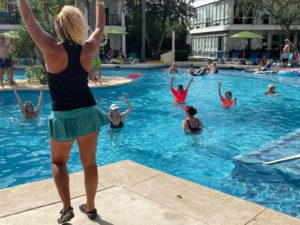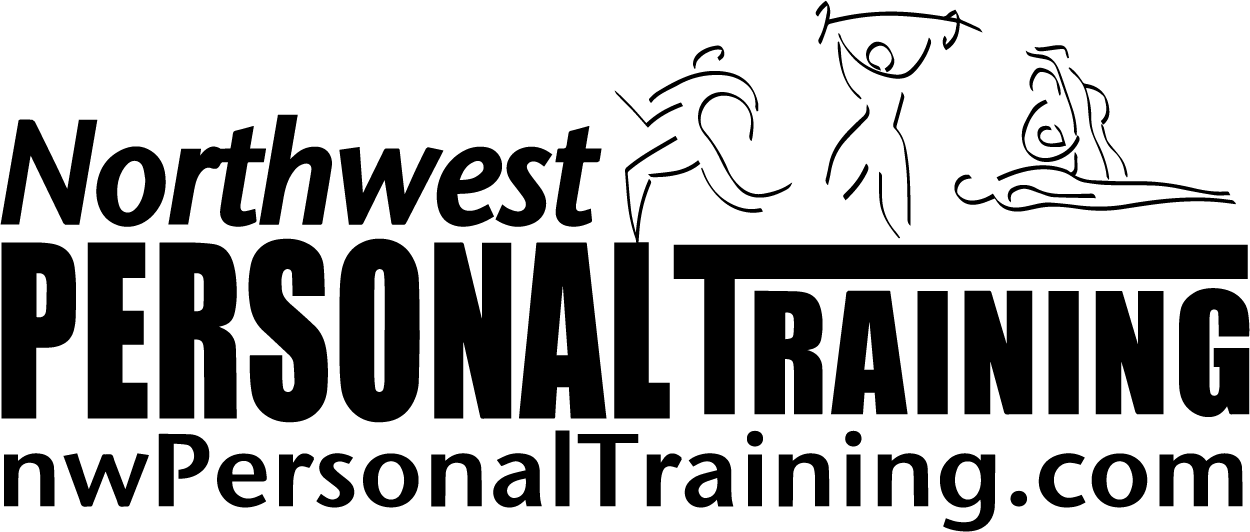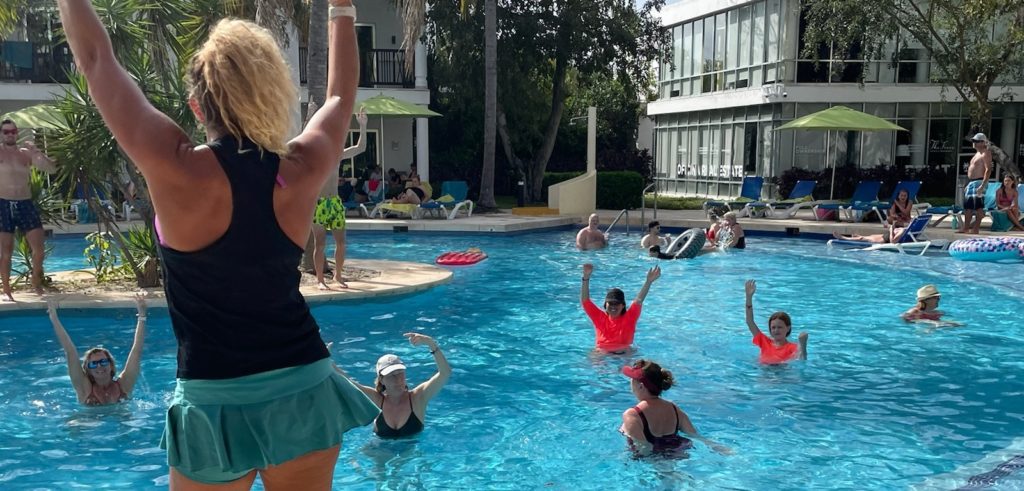Aqua fitness can improve cardiovascular health, develop muscle strength and endurance, increase flexibility, decrease body fat, improve circulation, help rehabilitate injuries, and even enhance sports skills. In addition, water fitness is a fun, social activity, and if you participate in an organized program, it’s a great way to meet new people with similar interests.
In fact, many people pre fer Aqua fitness year-round for the following reasons:
fer Aqua fitness year-round for the following reasons:
The buoyancy of water allows people to do exercises that are too difficult for them on land. Ninety percent of your body is buoyant when the water is up to your neck, so your body is exposed to a lot less pounding and jarring.
Water offers 12-14% more resistance in comparison to exercising on land. This means there is continual resistance to every move you make which enhances muscle definition.
Water disperses heat more efficiently, so there is less chance of overheating. Exercising in the water is cooler and more comfortable than it is on land.
Don’t forget to sign up under “Weekly Fitness Tips” to automatically receive my latest blog post in your inbox!
If you don’t have a home pool and need to venture out to a local pool, consider the following suggestions:
Check Out The Facility
Look for a pool that is clean, appears safe and is well-maintained. The water temperature should be comfortable: 82 to 84 degrees Fahrenheit (28-29 degrees Celsius). Inquire about the types of classes available. A facility that offers a lot of water fitness tools such as buoyancy belts and dumbbells, gloves, noodles and paddles will probably provide a greater variety of programming options.
Check Out The Instructors
Be sure the instructors are certified water fitness instructors and not just lifeguards to ensure they have the proper training to modify movements and intensity depending on your needs.
Know Your Limitations
Luckily, water fitness is one of the safest activities you can do for a variety of special conditions including pregnancy, orthopedic problems and arthritis. However, it’s always a good idea to inform your instructor of any medical or injury issues. If you can’t swim, it’s safest to stick to programs that will be instructed in shallow water.
Many exercisers are surprised to learn how many workout options are available to them in the water and/or pool:
Water Walking
Moving forward, backward, and sideways, using regular, short, quick, or long steps, in waist-deep to chest-deep water.
Water Aerobics
Full body rhythmic exercises conducted in shallow and/or deep water for 20 minutes or more, designed to provide cardiovascular benefits.
Water Toning/Strength Training
Upper and lower body moves designed to strengthen, firm, and sculpt the muscles by using the resistance of the water and/or water exercise equipment.
Flexibility Training
Large movements using each body part’s full range of motion, along with full body stretches.
Water Therapy & Rehabilitation
Procedures in the water designed and implemented for specific clinical purposes.
Water Yoga & Relaxation
Gentle, easy-flowing moves using the water as a relaxation medium.
Deep Water Running
Simulating land running in water depth where the feet do not touch the bottom of the pool. Flotation devices are used. Various running styles, drills, and methods can be used.
Wall Exercise (Deep or Shallow)
Using the pool wall for support to isolate various body parts.
Lap Swimming
If you are a proficient swimmer, of course you can always resort to swimming back and forth using various swimming strokes to obtain a great workout. However, it is still suggested that lap swimmers also consider other forms of water exercise in addition to lap swimming to maintain balance in their muscles.
Aqua Zumba
Think of it like a dance party in the pool!
Call your local pool to find out which programs are offered.
Yours in health & fitness,
Sherri McMillan


